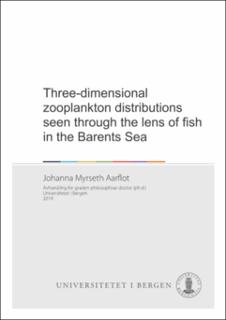| dc.contributor.author | Aarflot, Johanna Myrseth | |
| dc.date.accessioned | 2019-05-16T12:54:06Z | |
| dc.date.available | 2019-05-16T12:54:06Z | |
| dc.date.issued | 2019-04-08 | |
| dc.identifier.uri | http://hdl.handle.net/1956/19660 | |
| dc.description.abstract | My aim with this dissertation is to enhance our knowledge of food availability and foraging opportunities for planktivorous fish over the Barents Sea bathymetry. The Barents Sea is a highly productive sub-Arcic shelf sea supporting some of the largest fish stocks in the world. Lipid-rich calanoid copepods are key prey for fish and other planktivore predators in northern latitude ecosystems. Visual detection of individual prey is the dominant foraging mode in planktivorous fish, and prey detection is arguably the most limiting phase in the predation process. Light is a prerequisite for visual foraging and decreases exponentially with depth in aquatic systems. Furthermore, vertical movement has become a widespread strategy among Calanus and other zooplankton for avoiding visual predation. The bathymetry may, however, constrain vertical distributions and force zooplankton into more illuminated parts of the water column. Environmental constraints on distributions may be important for fish searching for zooplankton and affect predator-prey dynamics in pelagic ecosystems. In Paper I, we focus on Calanus spp. and use an extensive (30-year period) dataset on zooplankton biomass and species-specific abundance to show that calanoid copepods are a major driver of variation in zooplankton biomass in this ecosystem. Calanus finmarchicus, C. glacialis and C. hyperboreus constitute on average 80 % of the total biomass, and older copepodites (stages CIV and CV) make the largest contribution. The Calanus species co-occur in all areas, and interspecific variation in spatial biomass distribution may be related to the distribution of water masses. Biomass of Calanus spp. increases with bottom depth, but does this mean that prey is more available to fish in deeper parts of the Barents Sea? In Paper II, we utilize a unique dataset on vertical zooplankton distributions to determine the weighted mean depth (WMD) of zooplankton in three size fractions and assess the effect of topography and light on the depth distributions. The vertical dimension of the prey field is important for fish that are constrained by light in their search for prey. We show that the bathymetry constrains the zooplankton depth distribution; all size fractions have deeper distributions with increasing bottom depth. Distributions are shallower when the water is less clear, however the effect of water clarity is secondary compared to the effect of topography, and most pronounced in deeper (> 300 m) areas. Furthermore, zooplankton over banks are exposed to several orders of magnitude more light compared to zooplankton in deeper areas where distributions are less constrained by the bathymetry. This has a large effect on the theoretical visual range of fish, which declines as zooplankton WMD deepens. Zooplankton WMD does, however, only indicate where the weight of zooplankton is standing in the water column. To further investigate how the bathymetry structures foraging opportunities for fish, we use the vertical zooplankton biomass profiles as input to a visual foraging model and quantify the integrated prey encounter rate for fish over the bathymetry (Paper III). Our results demonstrate that fish may encounter significantly more large zooplankton (> 2 mm) in areas shallower than 200 m, even though the abundance is higher in deeper areas. Banks in the northern Barents Sea appear to be particularly attractive foraging habitats, as prey here is forced into greater light exposure. Furthermore, analyses of copepod filling in capelin stomachs support these predictions and suggest that capelin foraging on copepods have been more successful over shallow bathymetries > 200 m. Due to visual constraints on prey detection, the fish’ ability to utilize the zooplankton biomass m-2 is non-linearly related to the zooplankton WMD, and greater in shallow areas. Evaluating food availability for planktivorous fish using vertical zooplankton distributions presents a different picture than the spatial patterns in prey abundance. Results in my dissertation highlight the importance of bathymetry for fish foraging efficiency and predator-prey dynamics in pelagic ecosystems. Furthermore, my results convey a new perspective on capelin feeding migrations and regional variation in trophic control, which may increase our general understanding of ecosystem structure and function. | en_US |
| dc.language.iso | eng | eng |
| dc.publisher | The University of Bergen | en_US |
| dc.relation.haspart | Paper I: Aarflot, JM, Skjoldal, HR, Dalpadado, P & Skern-Mauritzen, M. (2017) Contribution of Calanus species to the mesozooplankton biomass in the Barents Sea. ICES Journal of Marine Science 75 (7): 2342-2354. The article is available at: <a href="http://hdl.handle.net/1956/19658" target="blank"> http://hdl.handle.net/1956/19658</a> | en_US |
| dc.relation.haspart | Paper II: Aarflot, JM, Aksnes, DL, Opdal, AF, Skjoldal, HR & Fiksen, Ø. (2019) Caught in broad daylight: Topographic constraints of zooplankton depth distributions. Limnology and Oceanography 64 (3): 849-859. The article is available at: <a href="http://hdl.handle.net/1956/19659" target="blank"> http://hdl.handle.net/1956/19659</a> | en_US |
| dc.relation.haspart | Paper III: Aarflot, JM, Dalpadado, P, Skjoldal, HR & Fiksen, Ø. Hide and seek: Foraging opportunities for planktivorous fish shaped by constraints on vertical zooplankton distributions. The article is not available in BORA. | en_US |
| dc.title | Three-dimensional zooplankton distributions seen through the lens of fish in the Barents Sea | en_US |
| dc.type | Doctoral thesis | |
| dc.rights.holder | Copyright the author. All rights reserved | en_US |
| dc.identifier.cristin | 1690304 | |
